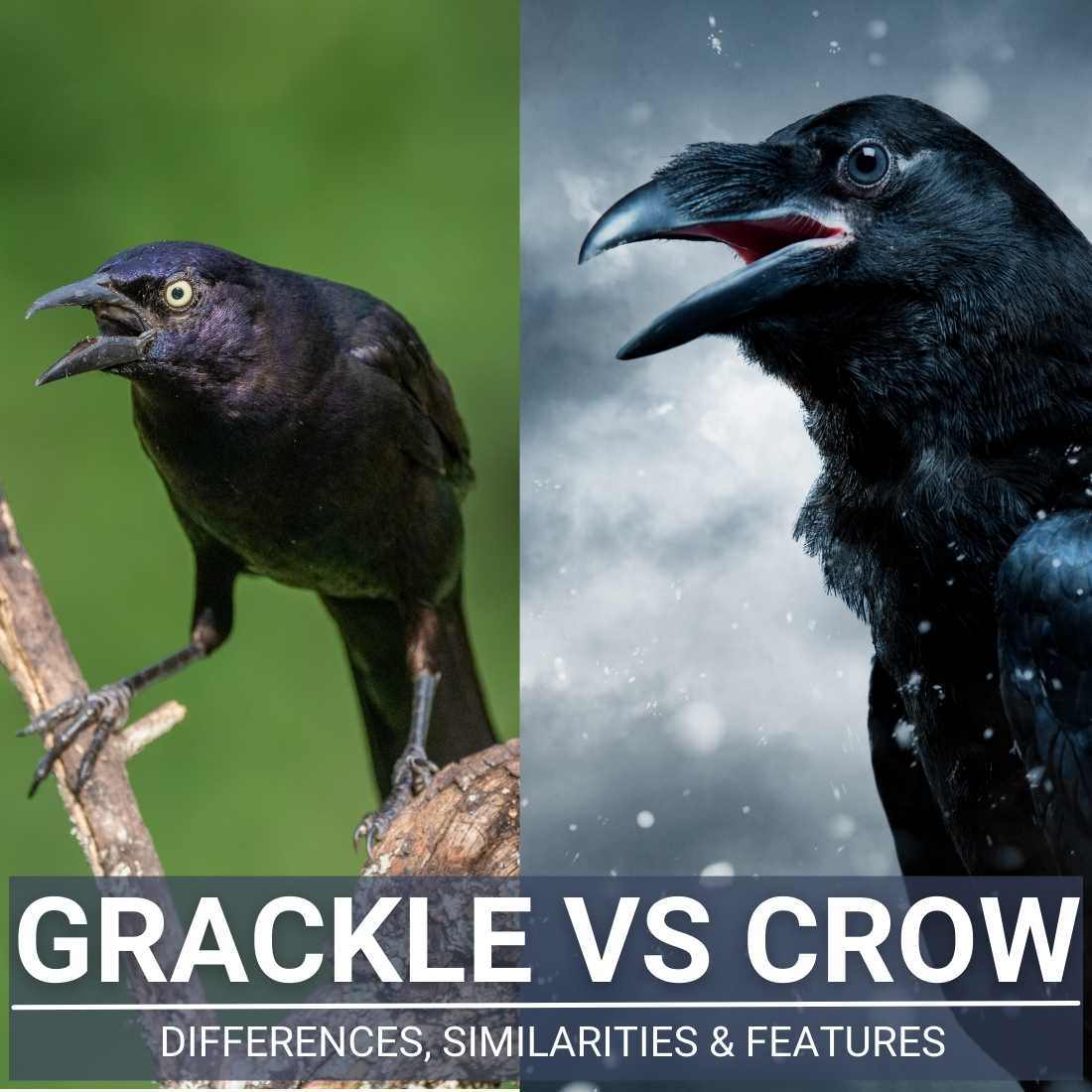Grackle Vs Crow: two birds, often mistaken for each other, yet each with its unique charm and characteristics. Ever wondered why the bird in your backyard has a longer tail or a different call? You might be looking at a grackle, not a crow!
Table of Contents
In this article, we’ll delve into the fascinating world of these two birds, exploring their differences and similarities. So, whether you’re an avid birdwatcher or a curious reader, stay tuned to discover the intriguing secrets of grackles and crows!
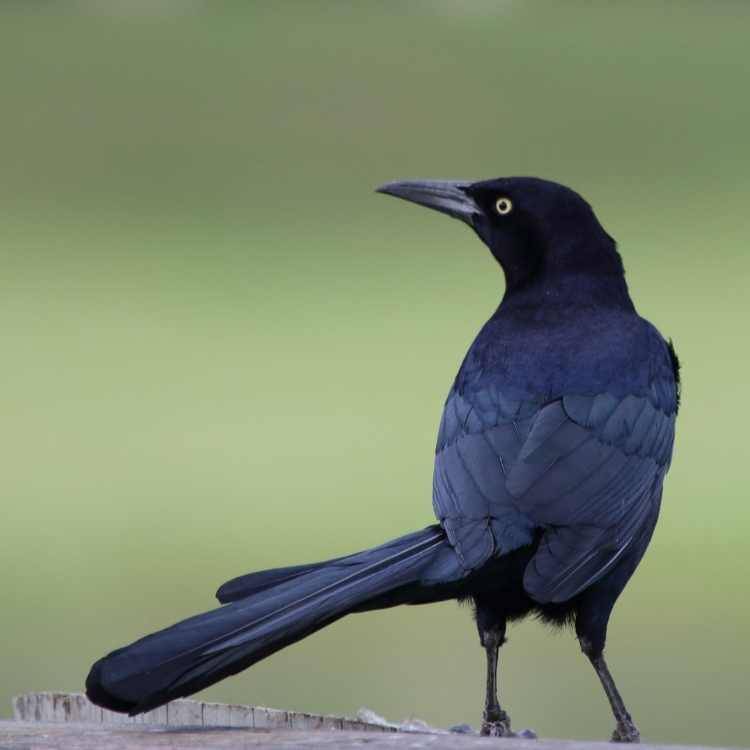
Key takeaways
- Size: Grackles are smaller than crows, with different body proportions.
- Plumage: Grackles have iridescent feathers, while crows have solid black plumage.
- Sociability: Grackles are highly sociable and often seen in large flocks, while crows can be solitary or form small groups.
- Vocalizations: Grackles have a varied repertoire of vocalizations, while crows have their distinctive “caw” call.
- Habitat: Grackles prefer open areas, including urban environments, while crows can adapt to various habitats, including forests and urban areas.
Overview Crow vs Grackle
| Grackle | Crow |
|---|---|
| Grackles make rusty gate hinge sounds. | They produce coos, rattles, caws, and click calls. |
| Keel-shaped tail | Fan-shaped tail |
| Slender body | Bulkier body |
| Small in size (equal to robin) | Large in size |
| Striking golden eyes | Brown or white eyes |
| Have long tails relative to their body size | Short tails relative to their body size |
| Make a flock up to 10-30 pairs. | Flock size is between 2-8 birds |
| Blue feathers in a rainbow of colors | Feather color usually depends upon indigenous species. Primarily black with somewhat brown, white or blue. |
| Usually eat tiny seeds, small fish and worms. | Eat almost anything they fit in their mouth. |
| The average lifespan is 17-22 years (wild) | The average lifespan is 13-20 years (wild) |
| Low to medium migrant | Partially migratory birds |
| Usually have 1-7 eggs in one clutch | Have 3-5 eggs in on the clutch |
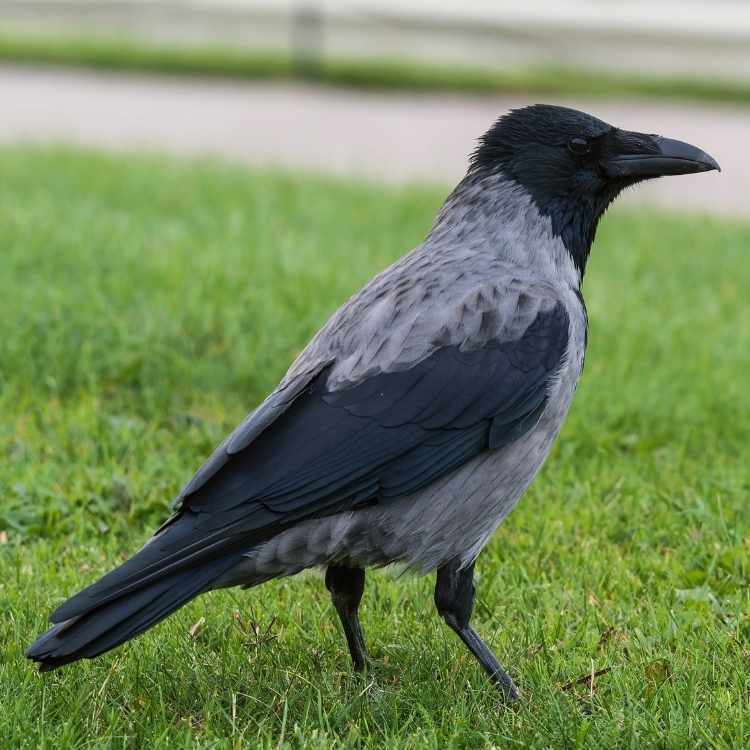
Overview of Grackles
Grackles are a type of blackbird that is often mistaken for crows due to their similar coloration. However, they have distinct characteristics that set them apart. Grackles are typically taller and longer-tailed than a typical blackbird, with a longer, more tapered bill and glossy-iridescent bodies. They’re known for their ability to adapt to different environments and their varied diet.
In North America, there are several types of grackles, including:
- Common Grackle
- Boat-tailed Grackle
- Great-tailed Grackle
Each type has its unique features and habitats. For more detailed information about grackles, you can visit All About Birds – Grackle.
Overview of Crows
Crows are large, intelligent, all-black birds that are familiar sights in many parts of North America. They are known for their hoarse, cawing voices and their unique, methodical flight style.
Crows are omnivores, feeding on a wide range of food items, including earthworms, insects, seeds, fruits, garbage, and even chicks they rob from nests.
There are several types of crows in North America:
- American Crow (most common)
- Fish Crow
- Hooded Crow
- Northwestern Crow
Each has its unique characteristics and habitats.
Physical Differences between Grackle vs Crow
When distinguishing between grackles and crows, there are several physical characteristics to consider.
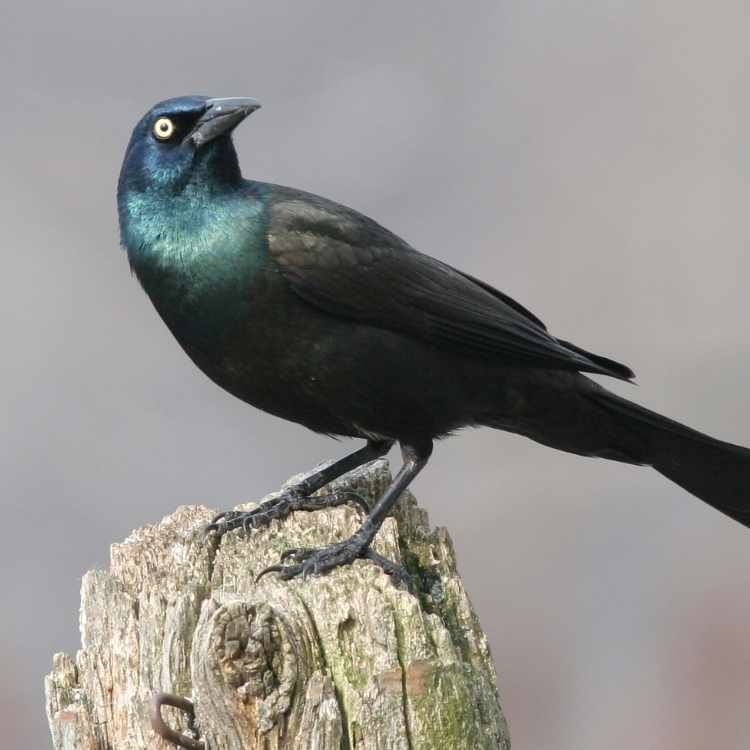
Size and Shape
Grackles and crows are both fascinating birds, each with their unique characteristics. Grackles are moderate-sized blackbirds, smaller than crows, typically ranging in length from 11 to 13 inches, with a wingspan of 15 to 18 inches, and weighing between 2.7–5.0 ounces.
Although grackles are less dimorphic than crows, their sexes can still be distinguished easily. They are distinguished by their long, pointed, black bills and golden eyes. Their tails are lengthy and formed like a keel, which is a unique feature.
On the other hand, crows are massive birds with long necks that some might find intimidating. Their wings are broad with forward-facing wingtips, and their tails are typically fan-shaped, differing from the keel shape of grackles. Crows have a variety of sizes due to many subspecies.
The American crow reaches a height of around 17 inches—the fish crow measures approximately 19 inches in length. The common crow is substantially bigger, reaching a length of roughly 28 inches. Crows weigh between 11 and 58 ounces on average, depending on the species.
Color and Plumage
The feathers of grackles are black with shiny, iridescent glitter. Their heads, necks, and breasts often exhibit glossy hues of purple-blue or blue-green. However, grackles in various locations of North America have slightly distinct plumage colors. For instance, the grackle subspecies in New England have a bronze-colored sheen.
Crows, in contrast, have feathers that range in color from violet to black, green to brown, or cyan to white. The brown color in some crows is due to the process of molting.
Beak and Tail Differences
Grackles have long, pointed, black bills, while crows have a black, curved beaks. The tails of grackles are lengthy and keel-shaped, while crows typically have a fan-shaped tails.
Understanding these physical differences can help in correctly identifying these birds.
| Physical Feature | Grackle | Crow |
|---|---|---|
| Size | Moderate-sized blackbirds | Larger than grackles |
| Bill | Long, pointed, black bills | Black, curved beak |
| Eyes | Golden eyes | Dark eyes |
| Tail | Lengthy, keel-shaped tails | Fan-shaped tails |
| Feathers | Black with shiny, iridescent glitter | Range in color from violet to black, green to brown, or cyan to white |
| Plumage Variation | Slight variations in plumage colors across different regions. Bronze-colored sheen in New England subspecies | Brown color in some crows due to molting |
| Wings | Normal wing span | Broad wings with forward-facing wingtips |
| Body Shape | Sleek and slender body | Robust and sturdy body |
| Leg Color | Dark-colored legs | Dark-colored legs |
| Neck | Shorter neck | Long neck |
Behavioral Differences
When it comes to behavior, grackles, and crows exhibit distinct patterns that set them apart.
Feeding Habits
Grackles are known for their sociable nature. They often form large flocks, which can include other bird species like blackbirds and cowbirds. Despite their sociable nature, grackles can be aggressive, especially when it comes to feeding. They are known to attack fellow grackles and other bird species by nipping, scratching, clawing, and flying at their prey. Grackles feed on the eggs and nestlings of other birds and occasionally kill and consume other adult birds. They frequently consume adult house sparrows.
Crows, on the other hand, have different feeding habits. While some crow species are solitary, others form groups. They are known to swarm around a deceased crow in a behavior that resembles a casual funeral. This gathering is more about understanding the cause of death than mourning the deceased.
Diet
The Grackle is a competent forager who eats a wide variety of diets. It eats a diverse range of seeds, including those from agricultural crops such as maize. Additionally, the Grackle will go into the water in order to grab a tiny fish, pick parasites off turtles, take worms from other birds, and on rare occasions, consume other adult birds. They have a hard portion of their beak to see open acorns, which is unique to the Grackle.
On the other hand, Crows forage for food on the ground or in trees, consuming various items such as earthworms, spiders, and other small invertebrates, seeds, and fruit, among other things. Aside from that, they consume debris and carcasses.
Nesting and Breeding Behavior
During the mating season, grackles stay together at night when they are not incubating eggs. Breeding partners may construct a nest apart from other birds or in colonies of up to 200 nests. They fiercely protect the area surrounding their nest, even from humans.
Crows, however, have different nesting and breeding behaviors, which can vary among species. Some crows migrate to warmer areas within their region if required.
Vocalizations and Sounds
Both grackles and crows are known for their distinctive vocalizations, which can help in identifying these birds.
Grackle vs crow sound
| Behavioral Feature | Grackle | Crow |
|---|---|---|
| Sociability | Highly sociable, often form large flocks | Some species are solitary, others form groups |
| Aggression | Can be aggressive, especially during feeding | Varies among species |
| Feeding Habits | Feed on eggs, nestlings, and adult birds of other species | Omnivorous, feed on a wide range of food items |
| Nesting | Stay together at night during mating season, nests can be solitary or in colonies | Nesting behavior varies among species |
| Breeding | Breeding partners may construct a nest apart from other birds or in colonies | Breeding behavior varies among species |
| Territory Defense | Fiercely protect their nesting area | Defense behavior varies among species |
| Vocalizations | Known for their distinctive vocalizations | Known for their cawing voices |
| Interaction with Humans | Can be aggressive towards humans near their nest | Interaction varies among species |
| Migration | Non-migratory | Some species migrate to warmer areas within their region |
| Can be aggressive toward humans near their nest | No specific response observed | Known to swarm around a deceased crow |
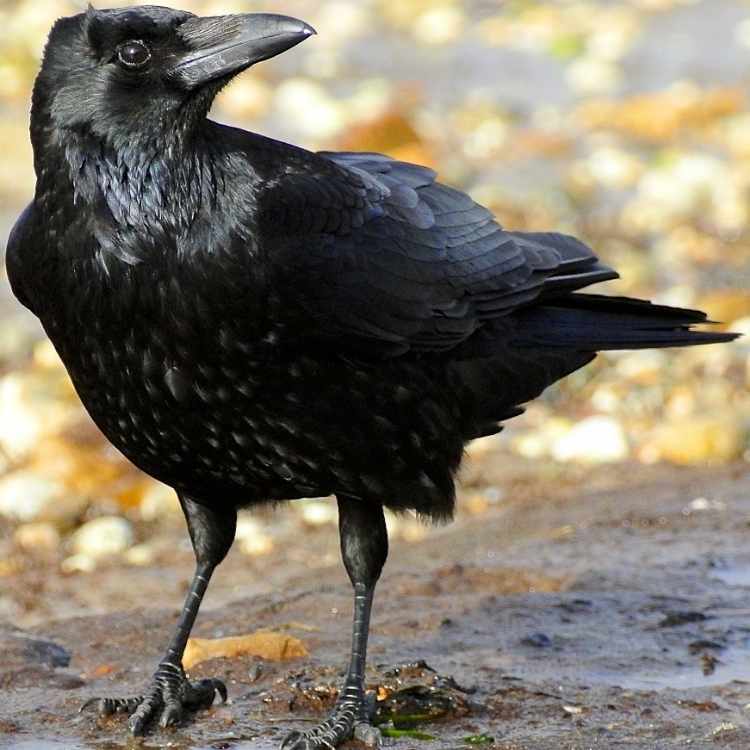
Habitat and Distribution
Grackles and crows are both widespread across North America, but they each have their preferred habitats.
Typical Habitats of Grackles and Crows
Grackles are found in a wide range of regions with dispersed trees, ideally conifers, as well as in areas where humans live. They are also found in agricultural areas, orchards, and marshes. Because grackles have adjusted so well to human habitats, they are abundant in open places such as housing areas, municipal parks, and graveyards.
Indeed, human modification of wooded ecosystems for farming has resulted in the growth of the range and population of grackles.
On the other hand, crows are astonishingly versatile birds found in practically any habitat. These birds inhabit forests, meadows, agricultural regions, ranches, hills, dunes, polar tundra, and riverbeds. They are found in both urban and rural environments, demonstrating their adaptability.
Geographic Distribution in North America
Grackles and crows are widespread across North America. The specific distribution can vary based on the species. For instance, the Common Grackle is found across much of the eastern and central United States, while the American Crow is found throughout the continent.
| Habitat and Distribution Feature | Grackle | Crow |
|---|---|---|
| Preferred Habitats | Regions with dispersed trees, human habitats, agricultural areas, orchards, marshes | Practically any habitat, including forests, meadows, agricultural regions, ranches, hills, dunes, polar tundra, and riverbeds |
| Urban Areas | Abundant in open places such as housing areas, municipal parks, and graveyards | Found in both urban and rural environments |
| Rural Areas | Found in agricultural areas and marshes | Found in both urban and rural environments |
| Forests | Found in regions with dispersed trees | Found in forests |
| Meadows | Less common | Found in meadows |
| Agricultural Regions | Found in agricultural areas | Found in agricultural regions |
| Ranches | Less common | Found in ranches |
| Hills | Less common | Found in hills |
| Dunes | Less common | Found in dunes |
| Polar Tundra | Less common | Found in polar tundra |
Interaction with Humans
Grackles and crows interact with humans in various ways, playing significant roles in the ecosystem and impacting agriculture and urban areas.
Role in the Ecosystem
Both grackles and crows play vital roles in the ecosystem. As omnivores, they help control the population of many insects and small animals. They also play a role in seed dispersal, contributing to the growth and spread of various plant species.
Impact on Agriculture and Urban Areas
Grackles and crows can have both positive and negative impacts on agriculture. On the one hand, they help control pests, but on the other hand, they can also damage crops. In urban areas, they are often seen as a nuisance due to their loud vocalizations and droppings. However, their presence also contributes to biodiversity in these areas.
Field Identification Tips Grackle Vs Crow
| Field Identification Tips | Grackle | Crow |
|---|---|---|
| Size | Moderate-sized blackbirds | Larger than grackles |
| Bill | Long, pointed, black bills | Black, curved beak |
| Eyes | Golden eyes | Dark eyes |
| Tail | Lengthy, keel-shaped tails | Fan-shaped tails |
| Feathers | Black with shiny, iridescent glitter | Range in color from violet to black, green to brown, or cyan to white |
| Plumage Variation | Slight variations in plumage colors across different regions | Brown color in some crows due to molting |
| Wings | Normal wing span | Broad wings with forward-facing wingtips |
| Body Shape | Sleek and slender body | Robust and sturdy body |
| Leg Color | Dark-colored legs | Dark-colored legs |
| Neck | Shorter neck | Long neck |
| Flight Pattern | Direct flight with rapid wing beats | Strong, steady wing beats with brief periods of wings pulled to the sides |
| Vocalization | Variety of squeaks, whistles and croaks | Distinctive “caw caw” sound |
| Flocking Behavior | Often seen in large flocks | May be seen alone or in pairs |
| Feeding Behavior | Can be aggressive during feeding | Less aggressive during feeding |
| Nesting Behavior | Nests can be solitary or in colonies | Nesting behavior varies among species |
| Habitat | Found in a wide range of regions with dispersed trees | Found in practically any habitat |
| Sociability | Highly sociable | Some species are solitary, others form groups |
| Interaction with Humans | Can be aggressive towards humans near their nest | Interaction varies among species |
| Migration | Non-migratory | Some species migrate to warmer areas within their region |
| Response to Death | No specific response observed | Known to swarm around a deceased crow |
FAQs
What is the relationship between grackles and crows?
Grackles and crows are both members of the larger bird family, but they belong to different genera. They share some similarities but also have distinct characteristics. Despite these differences, they often coexist in similar habitats.
How can I distinguish a grackle from a crow?
Grackles are smaller than crows, with iridescent feathers and golden eyes. Crows are larger, with all-black feathers and dark eyes. Their calls are also different. Observing these features can help you distinguish between the two.
What do grackles and crows eat?
Grackles and crows are omnivores. They eat a variety of foods, including insects, seeds, fruits, small animals, and garbage. Their diet varies based on availability and season.
Are grackles and crows harmful to crops or property?
Grackles and crows can damage crops by eating seeds and fruits. In urban areas, their droppings can be a nuisance. However, they also help control pests, which can be beneficial for maintaining ecological balance.
